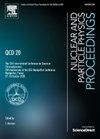CP2 上规量场的规不变度量
Q4 Physics and Astronomy
Nuclear and Particle Physics Proceedings
Pub Date : 2024-10-28
DOI:10.1016/j.nuclphysbps.2024.10.006
引用次数: 0
摘要
我们考虑生活在复投影空间 CP2 上的四维非阿贝尔规理论,以此来深入了解 (3+1)-dimensional QCD。特别是,我们使用了轨距场的复参数化,其上的轨距变换是均匀作用的。这样,我们就可以从体积元素中剔除量规自由度,从而得到量规轨道空间(所有量规势模量规变换的空间)的明显量规不变度量。该量度中出现的特别值得关注的项是轨距场的轨距不变模式的质量项。由于这些质量项带有维数参数,因此在维数嬗变中具有重要意义。此外,CP2 上局部规整不变质量项的存在可能与软胶子质量的施文格-戴森计算有关。最后,我们认为存在一个运动学机制,在这个机制中,理论可以用 4d Wess-Zumino-Witten(WZW)理论来近似。这一结果可用于总结四维和(2+1)维约束机制的相似性。本文章由计算机程序翻译,如有差异,请以英文原文为准。
A gauge-invariant measure for gauge fields on CP2
We consider four-dimensional non-Abelian gauge theory living on a complex projective space as a way of gaining insights into (3+1)-dimensional QCD. In particular, we use a complex parametrization of gauge fields on which gauge transformations act homogeneously. This allows us to factor out the gauge degrees of freedom from the volume element leading to a manifestly gauge-invariant measure for the gauge-orbit space (the space of all gauge potentials modulo gauge transformations). The terms appearing in the measure that are of particular interest are mass-like terms for the gauge-invariant modes of the gauge fields. Since these mass terms come with dimensional parameters they are significant in the context of dimensional transmutation. Moreover, the existence of local gauge-invariant mass terms on could be related to Schwinger-Dyson calculations of the soft gluon mass. Finally, we argue that there is a kinematic regime in which the theory can be approximated by a 4d Wess-Zumino-Witten (WZW) theory. This result can be used to draw similarities between the mechanism of confinement in four and (2+1) dimensions.
求助全文
通过发布文献求助,成功后即可免费获取论文全文。
去求助
来源期刊

Nuclear and Particle Physics Proceedings
Physics and Astronomy-Nuclear and High Energy Physics
CiteScore
0.40
自引率
0.00%
发文量
0
期刊介绍:
Nuclear and Particle Physics Proceedings is the premier publication outlet for the proceedings of key conferences on nuclear and high-energy physics and related areas. The series covers both large international conferences and topical meetings. The newest discoveries and the latest developments, reported at carefully selected meetings, are published covering experimental as well as theoretical particle physics, nuclear and hadronic physics, cosmology, astrophysics and gravitation, field theory and statistical systems, and physical mathematics.
 求助内容:
求助内容: 应助结果提醒方式:
应助结果提醒方式:


